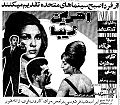Persian Film
Persian Film, also known as Filmfarsi (Persian: فیلمفارسی), is a term used in Pre-revolutionary Iranian cinema criticism that was coined by Iranian film critic . The term is used to describe low-quality films mostly copied from the Bollywood cinema and with poor plots, mostly arranged with dance and singing.[1][2] Filmfarsi were suppressed after the Iranian revolution by more strict laws on relations between men and women, as well as religious opposition to the content of the films. The suppression of the Filmfarsi genre encouraged the Iranian New Wave of modern films in Iranian cinema. Many of the Filmfarsi that survived the Iranian revolution did so thanks to the existence of illegal VHS copies.[3]
Description[]
According to BBC's Yousef Latifpour (یوسف لطیف پور), the plots of many Filmfarsi are based on "incredible accidents" or "exaggerated misunderstandings", where conflicts between tradition and modernism usually end "in favor of tradition".[4] Within Filmfarsi, there existed unique genres of film such as "Jāheli" (جاهلی), described by some as "hyper-masculine", in which tough male characters would save women from "a life of disgrace", such working as a prostitute or cabaret singer.[5][6] Other common genres of Iranian film prior to the Iranian revolution included thrillers, melodramas, musicals and action movies. While the films varied in theme, many of them shared common traits such as a "low production value" and "one-dimensional archetypes".[7]
Decline[]
The 1978 Cinema Rex fire is often seen as the catalyst for the demise of Filmfarsi; over 400 civilians were killed by Shiite revolutionaries while attending a screening of the controversial movie "The Deer".[8][9][10] After Iran became an Islamic Republic in 1979, many commonly seen features of Filmfarsi, such as women acting as an object of "sexual desire" or not wearing a hijab, were now frowned upon, and the genre was actively suppressed.[11][12]
Gallery[]

(1958)

Pretty Foe (1962)

King of Hearts (1968)

Shining Star (1969)

Reza Motorcyclist (1970)

Nikah Halala (1971)

The Dagger (1972)

Torkaman (1974)

Mashti Mamdali's Car (1974)

The Beehive (1975)

The Crookes (1974)
References[]
- ^ "مولفههای سینمای فیلمفارسی".
- ^ Talattof, Kamran (2011). Modernity, Sexuality, and Ideology in Iran: The Life and Legacy of a Popular Female Artist. Syracuse University Press. p. 12. ISBN 9780815651390. Retrieved 13 December 2017.
- ^ Khoshbakht, Ehsan (2021-03-12), Filmfarsi (Documentary), Pouri Baneai, Reza Beyk Imanverdi, Mohamad Ali Fardin, Fourouzan, retrieved 2021-03-31
- ^ "نگاهی دوباره به فیلمفارسی؛ از مهوش تا امین حیایی". BBC News فارسی (in Persian). 2015-09-25. Retrieved 2021-04-01.
- ^ Khoshbakht, Ehsan (2019-07-11). "How Iran's 'filmfarsi' remains the biggest secret in cinema history". the Guardian. Retrieved 2021-04-01.
- ^ "The Salesman turns a hyper-masculine Iranian film genre on its head by examining unintended self-destruction". nationalpost. Retrieved 2021-04-01.
- ^ "Review: "Filmfarsi" Reveals A Hidden Side to Iranian History Through Exploitation Cinema". Cinema Escapist. 2020-02-08. Retrieved 2021-04-01.
- ^ Haddad, Natalie (2019-09-10). "Filmfarsi Explores a Generation's Worth of Iranian Cinema". Hyperallergic. Retrieved 2021-04-01.
- ^ "Filmfarsi | IFFR". iffr.com. Retrieved 2021-04-01.
- ^ Byman, Daniel L. (2007-05-06). "The Rise of Low-Tech Terrorism". ISSN 0190-8286. Retrieved 2021-04-01.
- ^ "Excavating the Past Through Cinema: Ehsan Khoshbakht's "Filmfarsi"". MUBI. Retrieved 2021-04-01.
- ^ "Filmfarsi". Screen Slate. Retrieved 2021-04-01.
- Cinema of Iran
- Persian-language films
- Film genres
- Cinema by culture
- Film genre stubs











